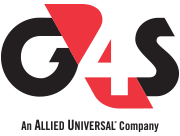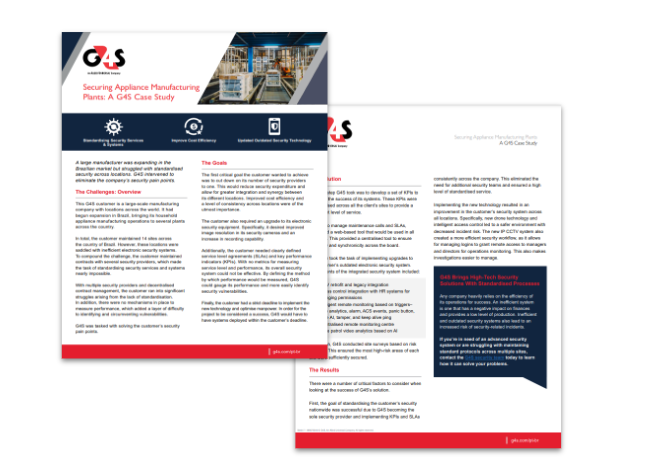Securing Appliance Manufacturing Plants

THE CHALLENGES: OVERVIEW
This G4S customer is a large-scale manufacturing company with locations across the world. It had begun expansion in Brazil, bringing its household appliance manufacturing operations to several plants across the country.
In total, the customer maintained 14 sites across the country of Brazil. However, these locations were saddled with inefficient electronic security systems. To compound the challenge, the customer maintained contracts with several security providers, which made the task of standardising security services and systems nearly impossible.
With multiple security providers and decentralised contract management, the customer ran into significant struggles arising from the lack of standardisation. In addition, there were no mechanisms in place to measure performance, which added a layer of difficulty to identifying and circumventing vulnerabilities. G4S was tasked with solving the customer’s security pain points.
THE GOALS
The first critical goal the customer wanted to achieve was to cut down on its number of security providers to one. This would reduce security expenditure and allow for greater integration and synergy between its different locations. Improved cost efficiency and a level of consistency across locations were of the utmost importance. The customer also required an upgrade to its electronic security equipment. Specifically, it desired improved image resolution in its security cameras and an increase in recording capability.
Additionally, the customer needed clearly defined service level agreements (SLAs) and key performance indicators (KPIs). With no metrics for measuring service level and performance, its overall security system could not be effective. By defining the method by which performance would be measured, G4S could gauge its performance and more easily identify security vulnerabilities.
Finally, the customer had a strict deadline to implement the new technology and optimise manpower. In order for the project to be considered a success, G4S would have to have systems deployed within the customer’s deadline.
THE SOLUTION
The first step G4S took was to develop a set of KPIs to measure the success of its systems. These KPIs were standardised across all the client’s sites to provide a consistent level of service. In order to manage maintenance calls and SLAs, G4S used a web-based tool that would be used in all locations. This provided a centralised tool to ensure efficiency and synchronicity across the board.
G4S then took the task of implementing upgrades to the customer’s outdated electronic security system. Components of the integrated security system included:
- CCTV retrofit and legacy integration
- Access control integration with HR systems for managing permissions
- Intelligent remote monitoring based on triggers–video analytics, alarm, ACS events, panic button, drone AI, tamper, and keep alive ping
- A centralised remote monitoring centre
- Drone patrol video analytics based on AI
In addition, G4S conducted site surveys based on risk analysis. This ensured the most high-risk areas of each site were sufficiently secured.
THE RESULTS
There were a number of critical factors to consider when looking at the success of G4S’s solution. First, the goal of standardising the customer’s security nationwide was successful due to G4S becoming the sole security provider and implementing KPIs and SLAs consistently across the company. This eliminated the need for additional security teams and ensured a high level of standardised service.
Implementing the new technology resulted in an improvement in the customer’s security system across all locations. Specifically, new drone technology and intelligent access control led to a safer environment with decreased incident risk. The new IP CCTV system also created a more efficient security workflow, as it allows for managing logins to grant remote access to managers and directors for operations monitoring. This also makes investigations easier to manage.
Download the PDF case study
If you would like this case study in PDF, please complete the form to gain access.

